 Backend Development
Backend Development
 Python Tutorial
Python Tutorial
 Python draws stunning Sankey diagrams, have you learned it?
Python draws stunning Sankey diagrams, have you learned it?
Python draws stunning Sankey diagrams, have you learned it?
Introduction to Sankey Diagram
Many times, we need a situation where we must visualize how data flows between entities. For example, take how residents move from one country to another. Here's a demonstration of how many residents moved from England to Northern Ireland, Scotland and Wales.
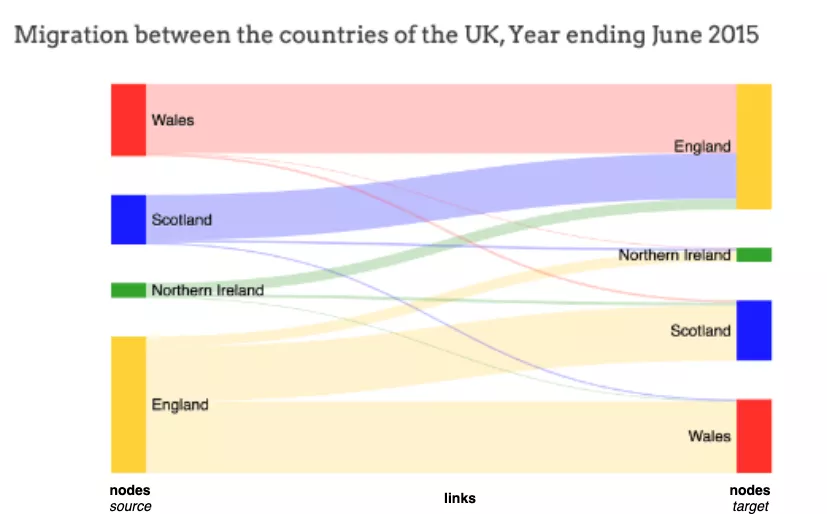
It is clear from this Sankey visualization that more residents moved from England to Wales than from Scotland or Northern Ireland.
What is a Sankey diagram?
Sankey diagrams usually depict the flow of data from one entity (or node) to another entity (or node).
The entities to which data flows are called nodes. The node where the data flow originates is the source node (for example, England on the left), and the node where the flow ends is the target node (for example, Wales on the right). Source and target nodes are usually represented as labeled rectangles.
The flow itself is represented by straight or curved paths, called links. The width of a stream/link is directly proportional to the volume/number of streams. In the example above, the movement from England to Wales (i.e. the migration of residents) is more extensive (i.e. the migration of residents) than the movement from England to Scotland or Northern Ireland (i.e. the migration of residents), indicating that more residents move to Wales than to other countries .
Sankey diagrams can be used to represent the flow of energy, money, costs, and anything that has a flow concept.
Minard's classic chart of Napoleon's invasion of Russia is probably the most famous example of a Sankey chart. This visualization using a Sankey diagram shows very effectively how the French army progressed (or decreased?) on its way to Russia and back.
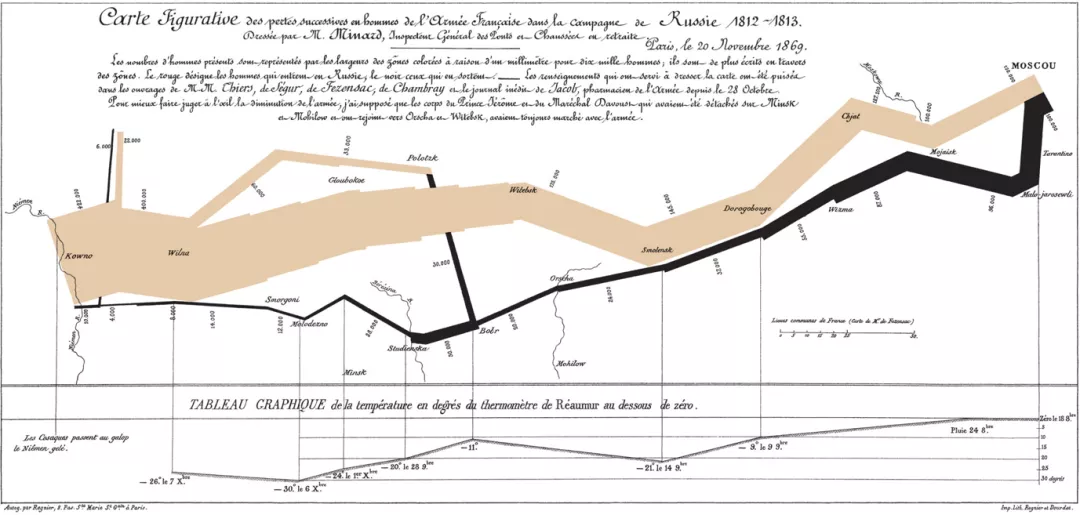
#In this article, we use python’s plotly to draw a Sankey diagram.
How to draw a Sankey diagram?
This article uses the 2021 Olympic Games data set to draw a Sankey diagram. The dataset contains detailed information about the total number of medals - country, total number of medals, and individual totals for gold, silver, and bronze medals. We plot a Sankey chart to find out how many gold, silver and bronze medals a country has won.
df_medals = pd.read_excel("data/Medals.xlsx")
print(df_medals.info())
df_medals.rename(columns={'Team/NOC':'Country', 'Total': 'Total Medals', 'Gold':'Gold Medals', 'Silver': 'Silver Medals', 'Bronze': 'Bronze Medals'}, inplace=True)
df_medals.drop(columns=['Unnamed: 7','Unnamed: 8','Rank by Total'], inplace=True)
df_medals<class 'pandas.core.frame.DataFrame'> RangeIndex: 93 entries, 0 to 92 Data columns (total 9 columns): # Column Non-Null CountDtype --------- ------------------- 0 Rank 93 non-null int64 1 Team/NOC 93 non-null object 2 Gold 93 non-null int64 3 Silver 93 non-null int64 4 Bronze 93 non-null int64 5 Total93 non-null int64 6 Rank by Total93 non-null int64 7 Unnamed: 7 0 non-nullfloat64 8 Unnamed: 8 1 non-nullfloat64 dtypes: float64(2), int64(6), object(1) memory usage: 6.7+ KB None
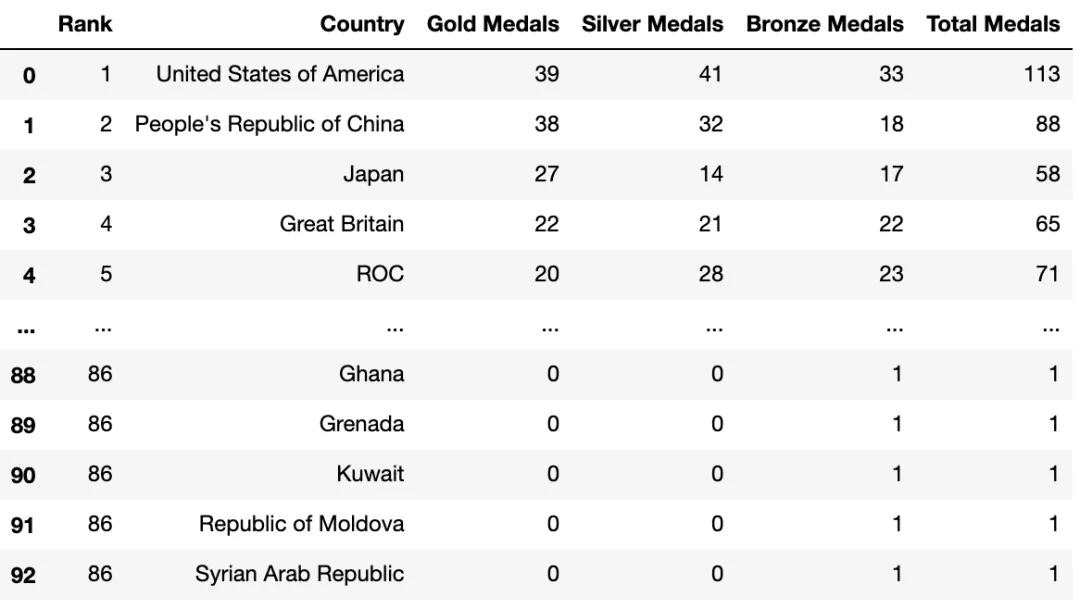
Sankey diagram drawing basics
Use plotly's go.Sankey, this method takes 2 parameters - nodes and links (nodes and links ).
Note: All nodes - source and target should have unique identifiers.
In the case of the Olympic medals data set in this article:
Source is the country. Consider the first 3 countries (United States, China, and Japan) as source nodes. Label these source nodes with the following (unique) identifiers, labels, and colors:
- 0: United States: Green
- 1: China: Blue
- 2: Japan: Orange
Target is gold, silver or bronze. Label these target nodes with the following (unique) identifiers, labels, and colors:
- 3: Gold Medal: Gold
- 4: Silver Medal: Silver
- 5 : Bronze: Brown
Link (between source node and target node) is the number of medals of each type. In each source there are 3 links, each ending with a target - Gold, Silver and Bronze. So there are 9 links in total. The width of each link should be the number of gold, silver and bronze medals. Tag these links to targets, values and colors with the following sources:
- 0 (US) to 3,4,5 : 39, 41, 33
- 1 (China) to 3 ,4,5 : 38, 32, 18
- 2 (Japan) to 3,4,5 : 27, 14, 17
You need to instantiate 2 python dict objects to Represents
- nodes (source and target): labels and colors as separate lists and
- links: source node, target node, value (width) and color of the link as separate List
and pass it to plotly's go.Sankey.
Each index of the list (label, source, target, value and color) corresponds to a node or link.
NODES = dict( # 0 1 23 4 5 label = ["United States of America", "People's Republic of China", "Japan", "Gold", "Silver", "Bronze"], color = ["seagreen", "dodgerblue", "orange", "gold", "silver", "brown" ],) LINKS = dict( source = [0,0,0,1,1,1,2,2,2], # 链接的起点或源节点 target = [3,4,5,3,4,5,3,4,5], # 链接的目的地或目标节点 value =[ 39, 41, 33, 38, 32, 18, 27, 14, 17], # 链接的宽度(数量) # 链接的颜色 # 目标节点: 3-Gold4-Silver5-Bronze color = [ "lightgreen", "lightgreen", "lightgreen",# 源节点:0 - 美国 States of America "lightskyblue", "lightskyblue", "lightskyblue",# 源节点:1 - 中华人民共和国China "bisque", "bisque", "bisque"],)# 源节点:2 - 日本 data = go.Sankey(node = NODES, link = LINKS) fig = go.Figure(data) fig.show()

This is a very basic Sankey diagram. But have you noticed that the chart is too wide and the silver medals appear before the gold medals?
Here’s how to adjust the position and width of nodes.
Adjust node positions and chart width
Add x and y positions to nodes to explicitly specify the node's position. Value should be between 0 and 1.
NODES = dict( # 0 1 23 4 5 label = ["United States of America", "People's Republic of China", "Japan", "Gold", "Silver", "Bronze"], color = ["seagreen", "dodgerblue", "orange", "gold", "silver", "brown" ],) x = [ 0,0,0,0.5,0.5,0.5], y = [ 0,0.5,1,0.1,0.5,1],) data = go.Sankey(node = NODES, link = LINKS) fig = go.Figure(data) fig.update_layout(title="Olympics - 2021: Country &Medals",font_size=16) fig.show()
So we got a compact Sankey diagram:
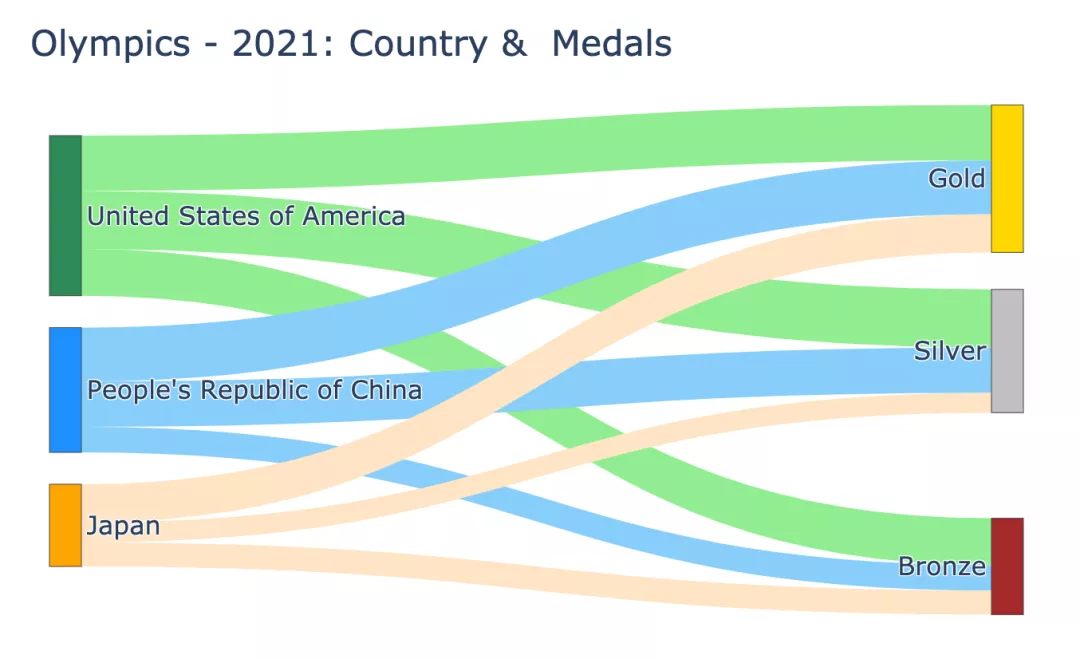
Let’s take a look at how the various parameters passed in the code are mapped to the nodes and nodes in the graph. Link.
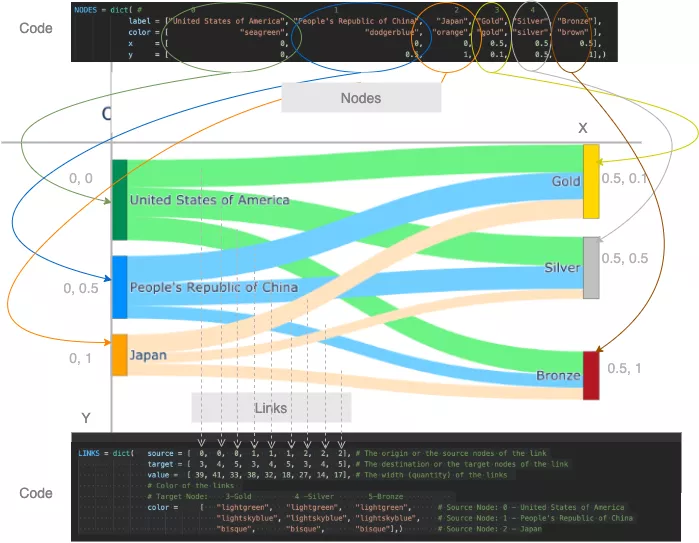
代码如何映射到桑基图
添加有意义的悬停标签
我们都知道plotly绘图是交互的,我们可以将鼠标悬停在节点和链接上以获取更多信息。
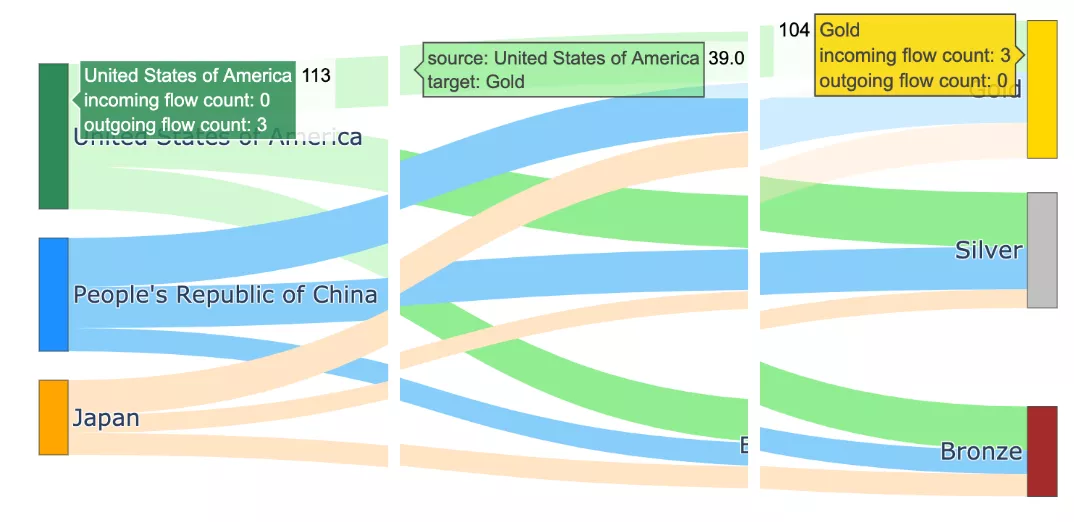
带有默认悬停标签的桑基图
当将鼠标悬停在图上,将会显示详细信息。悬停标签中显示的信息是默认文本:节点、节点名称、传入流数、传出流数和总值。
例如:
- 节点美国共获得11枚奖牌(=39金+41银+33铜)
- 节点金牌共有104枚奖牌(=美国39枚,中国38枚,日本27枚)
如果我们觉得这些标签太冗长了,我们可以对此进程改进。使用hovertemplate参数改进悬停标签的格式
- 对于节点,由于hoverlabels 没有提供新信息,通过传递一个空hovertemplate = ""来去掉hoverlabel
- 对于链接,可以使标签简洁,格式为-
- 对于节点和链接,让我们使用后缀"Medals"显示值。例如 113 枚奖牌而不是 113 枚。这可以通过使用具有适当valueformat和valuesuffix的update_traces函数来实现。
NODES = dict(
# 0 1 23 4 5
label = ["United States of America", "People's Republic of China", "Japan", "Gold", "Silver", "Bronze"],
color = ["seagreen", "dodgerblue","orange", "gold", "silver", "brown" ],
x = [ 0,0, 0,0.5,0.5,0.5],
y = [ 0,0.5, 1,0.1,0.5,1],
hovertemplate=" ",)
LINK_LABELS = []
for country in ["USA","China","Japan"]:
for medal in ["Gold","Silver","Bronze"]:
LINK_LABELS.append(f"{country}-{medal}")
LINKS = dict(source = [0,0,0,1,1,1,2,2,2],
# 链接的起点或源节点
target = [3,4,5,3,4,5,3,4,5],
# 链接的目的地或目标节点
value =[ 39, 41, 33, 38, 32, 18, 27, 14, 17],
# 链接的宽度(数量)
# 链接的颜色
# 目标节点:3-Gold4 -Silver5-Bronze
color = ["lightgreen", "lightgreen", "lightgreen", # 源节点:0 - 美国
"lightskyblue", "lightskyblue", "lightskyblue", # 源节点:1 - 中国
"bisque", "bisque", "bisque"],# 源节点:2 - 日本
label = LINK_LABELS,
hovertemplate="%{label}",)
data = go.Sankey(node = NODES, link = LINKS)
fig = go.Figure(data)
fig.update_layout(title="Olympics - 2021: Country &Medals",
font_size=16, width=1200, height=500,)
fig.update_traces(valueformat='3d',
valuesuffix='Medals',
selector=dict(type='sankey'))
fig.update_layout(hoverlabel=dict(bgcolor="lightgray",
font_size=16,
font_family="Rockwell"))
fig.show("png") #fig.show()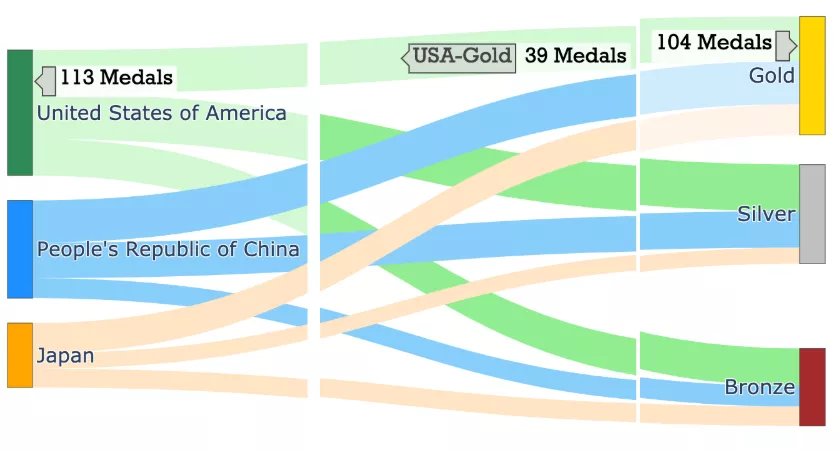
带有改进的悬停标签的桑基图
对多个节点和级别进行泛化相对于链接,节点被称为源和目标。作为一个链接目标的节点可以是另一个链接的源。
该代码可以推广到处理数据集中的所有国家。
还可以将图表扩展到另一个层次,以可视化各国的奖牌总数。
NUM_COUNTRIES = 5
X_POS, Y_POS = 0.5, 1/(NUM_COUNTRIES-1)
NODE_COLORS = ["seagreen", "dodgerblue", "orange", "palevioletred", "darkcyan"]
LINK_COLORS = ["lightgreen", "lightskyblue", "bisque", "pink", "lightcyan"]
source = []
node_x_pos, node_y_pos = [], []
node_labels, node_colors = [], NODE_COLORS[0:NUM_COUNTRIES]
link_labels, link_colors, link_values = [], [], []
# 第一组链接和节点
for i in range(NUM_COUNTRIES):
source.extend([i]*3)
node_x_pos.append(0.01)
node_y_pos.append(round(i*Y_POS+0.01,2))
country = df_medals['Country'][i]
node_labels.append(country)
for medal in ["Gold", "Silver", "Bronze"]:
link_labels.append(f"{country}-{medal}")
link_values.append(df_medals[f"{medal} Medals"][i])
link_colors.extend([LINK_COLORS[i]]*3)
source_last = max(source)+1
target = [ source_last, source_last+1, source_last+2] * NUM_COUNTRIES
target_last = max(target)+1
node_labels.extend(["Gold", "Silver", "Bronze"])
node_colors.extend(["gold", "silver", "brown"])
node_x_pos.extend([X_POS, X_POS, X_POS])
node_y_pos.extend([0.01, 0.5, 1])
# 最后一组链接和节点
source.extend([ source_last, source_last+1, source_last+2])
target.extend([target_last]*3)
node_labels.extend(["Total Medals"])
node_colors.extend(["grey"])
node_x_pos.extend([X_POS+0.25])
node_y_pos.extend([0.5])
for medal in ["Gold","Silver","Bronze"]:
link_labels.append(f"{medal}")
link_values.append(df_medals[f"{medal} Medals"][:i+1].sum())
link_colors.extend(["gold", "silver", "brown"])
print("node_labels", node_labels)
print("node_x_pos", node_x_pos); print("node_y_pos", node_y_pos)node_labels ['United States of America', "People's Republic of China", 'Japan', 'Great Britain', 'ROC', 'Gold', 'Silver', 'Bronze', 'Total Medals'] node_x_pos [0.01, 0.01, 0.01, 0.01, 0.01, 0.5, 0.5, 0.5, 0.75] node_y_pos [0.01, 0.26, 0.51, 0.76, 1.01, 0.01, 0.5, 1, 0.5]
# 显示的图
NODES = dict(pad= 20, thickness = 20,
line = dict(color = "lightslategrey",
width = 0.5),
hovertemplate=" ",
label = node_labels,
color = node_colors,
x = node_x_pos,
y = node_y_pos, )
LINKS = dict(source = source,
target = target,
value = link_values,
label = link_labels,
color = link_colors,
hovertemplate="%{label}",)
data = go.Sankey(arrangement='snap',
node = NODES,
link = LINKS)
fig = go.Figure(data)
fig.update_traces(valueformat='3d',
valuesuffix=' Medals',
selector=dict(type='sankey'))
fig.update_layout(title="Olympics - 2021: Country &Medals",
font_size=16,
width=1200,
height=500,)
fig.update_layout(hoverlabel=dict(bgcolor="grey",
font_size=14,
font_family="Rockwell"))
fig.show("png") 
The above is the detailed content of Python draws stunning Sankey diagrams, have you learned it?. For more information, please follow other related articles on the PHP Chinese website!

Hot AI Tools

Undresser.AI Undress
AI-powered app for creating realistic nude photos

AI Clothes Remover
Online AI tool for removing clothes from photos.

Undress AI Tool
Undress images for free

Clothoff.io
AI clothes remover

Video Face Swap
Swap faces in any video effortlessly with our completely free AI face swap tool!

Hot Article

Hot Tools

Notepad++7.3.1
Easy-to-use and free code editor

SublimeText3 Chinese version
Chinese version, very easy to use

Zend Studio 13.0.1
Powerful PHP integrated development environment

Dreamweaver CS6
Visual web development tools

SublimeText3 Mac version
God-level code editing software (SublimeText3)

Hot Topics
 1387
1387
 52
52
 Is the vscode extension malicious?
Apr 15, 2025 pm 07:57 PM
Is the vscode extension malicious?
Apr 15, 2025 pm 07:57 PM
VS Code extensions pose malicious risks, such as hiding malicious code, exploiting vulnerabilities, and masturbating as legitimate extensions. Methods to identify malicious extensions include: checking publishers, reading comments, checking code, and installing with caution. Security measures also include: security awareness, good habits, regular updates and antivirus software.
 How to run programs in terminal vscode
Apr 15, 2025 pm 06:42 PM
How to run programs in terminal vscode
Apr 15, 2025 pm 06:42 PM
In VS Code, you can run the program in the terminal through the following steps: Prepare the code and open the integrated terminal to ensure that the code directory is consistent with the terminal working directory. Select the run command according to the programming language (such as Python's python your_file_name.py) to check whether it runs successfully and resolve errors. Use the debugger to improve debugging efficiency.
 Can vs code run in Windows 8
Apr 15, 2025 pm 07:24 PM
Can vs code run in Windows 8
Apr 15, 2025 pm 07:24 PM
VS Code can run on Windows 8, but the experience may not be great. First make sure the system has been updated to the latest patch, then download the VS Code installation package that matches the system architecture and install it as prompted. After installation, be aware that some extensions may be incompatible with Windows 8 and need to look for alternative extensions or use newer Windows systems in a virtual machine. Install the necessary extensions to check whether they work properly. Although VS Code is feasible on Windows 8, it is recommended to upgrade to a newer Windows system for a better development experience and security.
 Can visual studio code be used in python
Apr 15, 2025 pm 08:18 PM
Can visual studio code be used in python
Apr 15, 2025 pm 08:18 PM
VS Code can be used to write Python and provides many features that make it an ideal tool for developing Python applications. It allows users to: install Python extensions to get functions such as code completion, syntax highlighting, and debugging. Use the debugger to track code step by step, find and fix errors. Integrate Git for version control. Use code formatting tools to maintain code consistency. Use the Linting tool to spot potential problems ahead of time.
 Choosing Between PHP and Python: A Guide
Apr 18, 2025 am 12:24 AM
Choosing Between PHP and Python: A Guide
Apr 18, 2025 am 12:24 AM
PHP is suitable for web development and rapid prototyping, and Python is suitable for data science and machine learning. 1.PHP is used for dynamic web development, with simple syntax and suitable for rapid development. 2. Python has concise syntax, is suitable for multiple fields, and has a strong library ecosystem.
 Can vscode be used for mac
Apr 15, 2025 pm 07:36 PM
Can vscode be used for mac
Apr 15, 2025 pm 07:36 PM
VS Code is available on Mac. It has powerful extensions, Git integration, terminal and debugger, and also offers a wealth of setup options. However, for particularly large projects or highly professional development, VS Code may have performance or functional limitations.
 Can vscode run ipynb
Apr 15, 2025 pm 07:30 PM
Can vscode run ipynb
Apr 15, 2025 pm 07:30 PM
The key to running Jupyter Notebook in VS Code is to ensure that the Python environment is properly configured, understand that the code execution order is consistent with the cell order, and be aware of large files or external libraries that may affect performance. The code completion and debugging functions provided by VS Code can greatly improve coding efficiency and reduce errors.
 Golang vs. Python: Concurrency and Multithreading
Apr 17, 2025 am 12:20 AM
Golang vs. Python: Concurrency and Multithreading
Apr 17, 2025 am 12:20 AM
Golang is more suitable for high concurrency tasks, while Python has more advantages in flexibility. 1.Golang efficiently handles concurrency through goroutine and channel. 2. Python relies on threading and asyncio, which is affected by GIL, but provides multiple concurrency methods. The choice should be based on specific needs.



